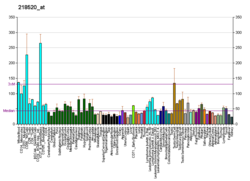TBK1 (TANK-binding kinase 1) is an enzyme with kinase activity. Specifically, it is a serine / threonine protein kinase.[5] It is encoded by the TBK1 gene in humans.[6] This kinase is mainly known for its role in innate immunity antiviral response. However, TBK1 also regulates cell proliferation, apoptosis, autophagy, and anti-tumor immunity.[5] Insufficient regulation of TBK1 activity leads to autoimmune, neurodegenerative diseases or tumorigenesis.[7][8]
- ^ a b c GRCh38: Ensembl release 89: ENSG00000183735 – Ensembl, May 2017
- ^ a b c GRCm38: Ensembl release 89: ENSMUSG00000020115 – Ensembl, May 2017
- ^ "Human PubMed Reference:". National Center for Biotechnology Information, U.S. National Library of Medicine.
- ^ "Mouse PubMed Reference:". National Center for Biotechnology Information, U.S. National Library of Medicine.
- ^ a b Helgason E, Phung QT, Dueber EC (April 2013). "Recent insights into the complexity of Tank-binding kinase 1 signaling networks: the emerging role of cellular localization in the activation and substrate specificity of TBK1". FEBS Letters. 587 (8): 1230–1237. doi:10.1016/j.febslet.2013.01.059. PMID 23395801.
- ^ "Entrez Gene: TBK1 TANK-binding kinase 1".
- ^ Louis C, Burns C, Wicks I (2018-03-06). "TANK-Binding Kinase 1-Dependent Responses in Health and Autoimmunity". Frontiers in Immunology. 9: 434. doi:10.3389/fimmu.2018.00434. PMC 5845716. PMID 29559975.
- ^ Cruz VH, Brekken RA (March 2018). "Assessment of TANK-binding kinase 1 as a therapeutic target in cancer". Journal of Cell Communication and Signaling. 12 (1): 83–90. doi:10.1007/s12079-017-0438-y. PMC 5842199. PMID 29218456.





